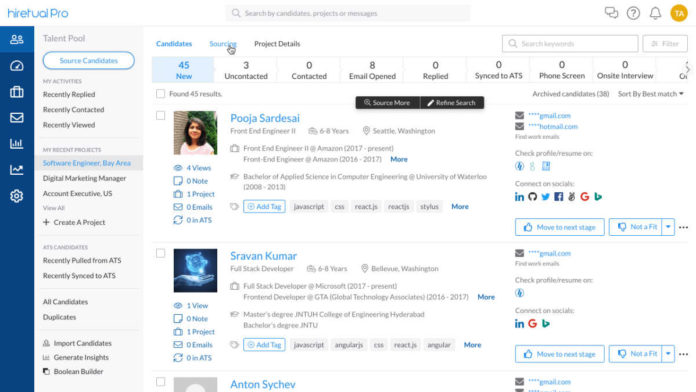
Sponsored
Data and technology are bedrocks of today’s talent acquisition world, but they also make the TA team’s job complex. Consider: When sourcing candidates, employers navigate through a range of data sets and systems. LinkedIn has its database, Indeed has another, Dice has another. Then, as they move into the guts of the search, employers must often work with multiple systems—the job board, the ATS, the HCM solution.
Is this an overly complicated approach? Can it be simplified? We discussed it with Hiretual CEO Steven Jiang.
In an ideal world, what would recruiting’s “infrastructure” look like? How would all of the different databases and systems be connected?
The talent acquisition function has been using disconnected technology for far too long, and that makes it difficult for teams to change existing processes quickly and adapt to circumstances they don’t see coming.
Let’s take 2020 for example. We were suddenly forced to uproot what we knew and make a digital shift, all while making sense of candidate data that was now coming in through video conferencing or interviewing software while we faced higher volumes of online applications, saturated social media content and so on.
If your usual workflow involves jumping around from platform to platform, manually importing and exporting data into spreadsheets and poring over them with the rest of your team, then your process isn’t dynamic enough to continuously try new things and optimize what’s broken as you’re adjusting to new norms.
Talent acquisition has evolved into this multi-layer structure of candidate information in a variety of data formats and structures. The ideal recruiting infrastructure is an intelligent talent data warehouse that manages and consolidates these different data types, including conversational data and activity data.
When we think about recruitment at Hiretual, we call it a talent data system because there’s just so much valuable information that can be analyzed and used to better target sourcing and engagement strategies. This isn’t the future of talent acquisition, it’s already here and it’s what we should be doing right now – anchoring our workflow to an all-in-one location that centralizes data and user activity from all these platforms and online channels.
Is what you envision possible, from a technology standpoint?
Yes, it definitely is. Look around us and you’ll notice that most business functions no longer rely on a single software to fit all their needs. It just isn’t a realistic solution anymore. We need an ecosystem of software to get value quickly.
When we think about how Salesforce transformed sales, it goes back to how software integrations for sales teams were revolutionized through the cloud. This recruiting infrastructure will do the same thing: Recruiters can easily integrate the services of their choice without having to program it themselves. They get access to more data types and they’re able to transform that data into something actionable and bring that back to hiring managers.
Hiretual’s Knowledge Graph helps us become that data warehouse for customers to extract data from different software products and services before transforming it into insights that teams can use to analyze and predict candidate behavior and forecast future recruiting goals.
Within this graph, billions of entities and trillions of edges form an intricate web of relationships between different sources of talent data. Then through natural language processing, the Hiretual graph becomes a scalable and responsive infrastructure that continues to learn and expand as it takes on more data from the open web and integrated systems.
It’s not magic, but it definitely makes the impossible feel possible because now you have an infrastructure that feeds on structured and unstructured data to help recruiters identify recurring patterns, conduct contextual searches and automate how different software products pass information to each other.
How about from a business and, for lack of a better term, a “human” standpoint?
At first, it may seem daunting for some recruiters when they see terms like “natural language processing” and “knowledge graphs,” and hear about how they’re going to change recruitment.
But the goal of this infrastructure is to build an environment where recruiters can have full flexibility and control of their business processes. Things like data migration, system integrations, list-cleaning and scrolling through databases don’t need human personalization but still take up large chunks of time. An infrastructure powered by data intelligence will give recruiters more confidence to let these processes run in the background while they devote more time to building genuine and intentional touch points with job seekers from all talent channels.
To understand how that happens, there needs to be a distinction made between AI automation and AI augmentation. Hiretual’s self-learning and self-expanding technology model doesn’t automate talent sourcing, it augments it. We put recruiters at the center of this infrastructure to drive AI and ultimately decide how they want to use it in their workflow. Augmentation is a non-static process, so it gives them a choice to be strategic about using technology and navigating its impacts.
At the end of the day, recruitment isn’t about pulling data–it’s about really understanding it. In this new age of work, recruiters help organizations reach their goals by selling the value of the company and envisioning a future for candidates who come through the door. It’s a proud profession and it takes a lot of work, a lot of resources and a lot of information to make one good hire.
Talent acquisition is changing. The pandemic, technology and generational shifts are all impacting the way companies source and hire candidates. What are the big changes you anticipate, and how should technology evolve to address them?
We’re going to have to redefine what talent acquisition will mean in an age of AI, emerging technologies and virtual communication. How should talent acquisition as a function adapt to these changes fast enough to see results and implement real action in the workplace? This is going to be especially important in 2021, as we’ll see more Gen Z employees, more hiring beyond proximate talent pools and more changes on the ground with workplace diversity and inclusion.
As we move forward from lessons learned in 2020, hiring teams will need to be proactive and adaptive to come out of the Great Rehire stronger than they were coming in. The Great Rehire will come knocking when employers across the board get their footing and pick hiring back up again, and it’s going to happen simultaneously for many companies. This year, 2021, is going to be an all-out war for talent, and having the slightest competitive edge will tip the odds in anyone’s favor.
Talent acquisition teams should continue to be open-minded about change and embrace technologies that will help them cut through a content-saturated digital environment and emerge in front of their candidates with all the information needed to have an impactful conversation.
Hiretual is the candidate data engine for all of your recruiting efforts. Integrate with your tech stack to centralize talent management – source across 750M+ profiles, build personalized engagement campaigns and actively rediscover lost profiles in your ATS. To find out more, visit Hiretual here.
Image: Hiretual














